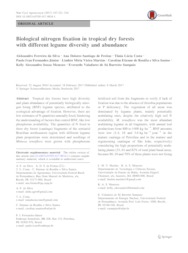Biological nitrogen fixation in tropical dry forests with different legume diversity and abundance.
Biological nitrogen fixation in tropical dry forests with different legume diversity and abundance.
Author(s): SILVA, A. F. da; FREITAS, A. D. S. de; COSTA, T. L.; FERNANDES JUNIOR, P. I.; MARTINS, L. M. V.; SANTOS, C. E. de R. e S.; MENEZES, K. A. S.; SAMPAIO, E. V. de S. B.
Summary: Tropical dry forests have high diversity and plant abundance of potentially biologically nitrogen fixing (BNF) legume species, attributed to the ecological advantage of fixation. However, there are few estimates of N quantities annually fixed, hindering the understanding of factors that control BNF, like low phosphorus availability. The quantities of N fixed in three dry forest (caatinga) fragments of the semiarid Brazilian northeastern region with different legume plant proportions were determined and seedlings of Mimosa tenuiflora were grown with phosphorous fertilized soil from the fragments to verify if lack of fixation was due to the absence of rhizobia populations or P deficiency. The vegetation of all areas was dominated by legume plants, mainly potentially nodulating ones, despite the relatively high soil N availability. M. tenuiflora was the most abundant nodulating legume in all fragments, with annual leaf productions from 800 to 1400 kg ha - 1 . BNF amounts were low (1.4, 18 and 3.6 kg ha - 1 year 1 in the mature caatinga of Petrolina and in the mature and regenerating caatingas of Sa ? o Joa ? o, respectively) considering the high proportions of potentially nodu- lating plants (33, 61 and 82% of total plant basal area), because 80, 10 and 70% of these plants were not fixing and those fixing had only 20?46% of their N derived from the atmosphere. Since the pot grown seedlings nodulated abundantly, the low BNF could not be explained by absence of microsymbionts but likely to low symbiosis efficiency due to relatively high N and low P availability.
Publication year: 2017
Types of publication: Journal article
Unit: Embrapa Semi-arid Region
Observation
Some of Embrapa's publications are published as ePub files. To read them, use or download one of the following free software options to your computer or mobile device. Android: Google Play Books; IOS: iBooks; Windows and Linux: Calibre.
Access other publications
Access the Agricultural Research Database (BDPA) to consult Embrapa's full library collection and records.
Visit Embrapa Bookstore to purchase books and other publications sold by Embrapa.

